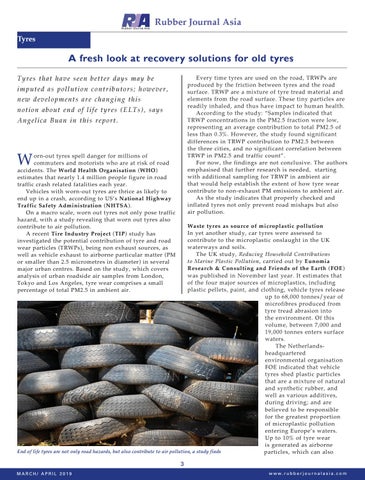Rubber Journal Asia Tyres
A fresh look at recovery solutions for old tyres Tyres that have seen better days may be
Every time tyres are used on the road, TRWPs are produced by the friction between tyres and the road surface. TRWP are a mixture of tyre tread material and elements from the road surface. These tiny particles are readily inhaled, and thus have impact to human health. According to the study: “Samples indicated that TRWP concentrations in the PM2.5 fraction were low, representing an average contribution to total PM2.5 of less than 0.3%. However, the study found significant differences in TRWP contribution to PM2.5 between the three cities, and no significant correlation between TRWP in PM2.5 and traffic count”. For now, the findings are not conclusive. The authors emphasised that further research is needed, starting with additional sampling for TRWP in ambient air that would help establish the extent of how tyre wear contribute to non-exhaust PM emissions to ambient air. As the study indicates that properly checked and inflated tyres not only prevent road mishaps but also air pollution.
imputed as pollution contributors; however, new developments are changing this
notion about end of life tyres (ELTs), says Angelica Buan in this report.
W
orn-out tyres spell danger for millions of commuters and motorists who are at risk of road accidents. The World Health Organisation (WHO) estimates that nearly 1.4 million people figure in road traffic crash related fatalities each year. Vehicles with worn-out tyres are thrice as likely to end up in a crash, according to US’s National Highway Traffic Safety Administration (NHTSA). On a macro scale, worn out tyres not only pose traffic hazard, with a study revealing that worn out tyres also contribute to air pollution. A recent Tire Industry Project (TIP) study has investigated the potential contribution of tyre and road wear particles (TRWPs), being non exhaust sources, as well as vehicle exhaust to airborne particular matter (PM or smaller than 2.5 micrometres in diameter) in several major urban centres. Based on the study, which covers analysis of urban roadside air samples from London, Tokyo and Los Angeles, tyre wear comprises a small percentage of total PM2.5 in ambient air.
Waste tyres as source of microplastic pollution In yet another study, car tyres were assessed to contribute to the microplastic onslaught in the UK waterways and soils. The UK study, Reducing Household Contributions to Marine Plastic Pollution, carried out by Eunomia Research & Consulting and Friends of the Earth (FOE) was published in November last year. It estimates that of the four major sources of microplastics, including plastic pellets, paint, and clothing, vehicle tyres release up to 68,000 tonnes/year of microfibres produced from tyre tread abrasion into the environment. Of this volume, between 7,000 and 19,000 tonnes enters surface waters. The Netherlandsheadquartered environmental organisation FOE indicated that vehicle tyres shed plastic particles that are a mixture of natural and synthetic rubber, and well as various additives, during driving; and are believed to be responsible for the greatest proportion of microplastic pollution entering Europe’s waters. Up to 10% of tyre wear is generated as airborne End of life tyres are not only road hazards, but also contribute to air pollution, a study finds particles, which can also
3 MARCH/ APRIL 2019
w w w. r u b b e r j o u r n a l a s i a . c o m
